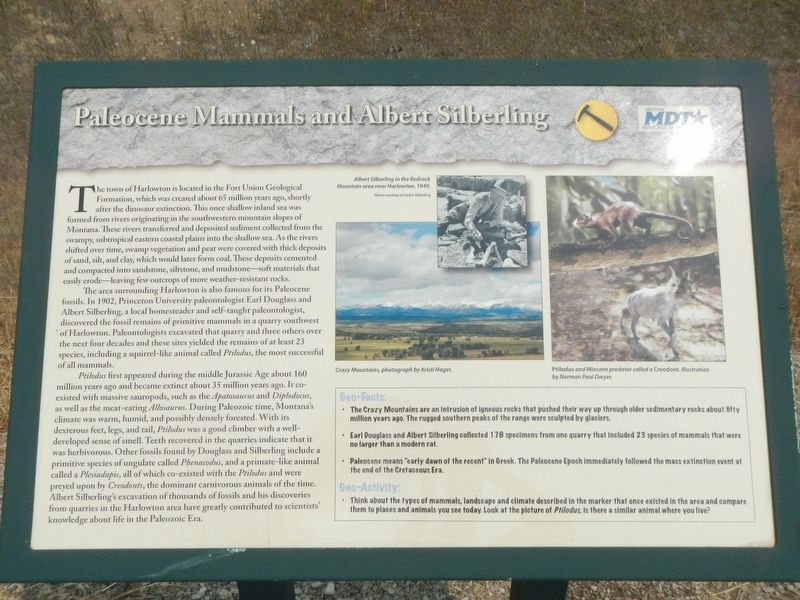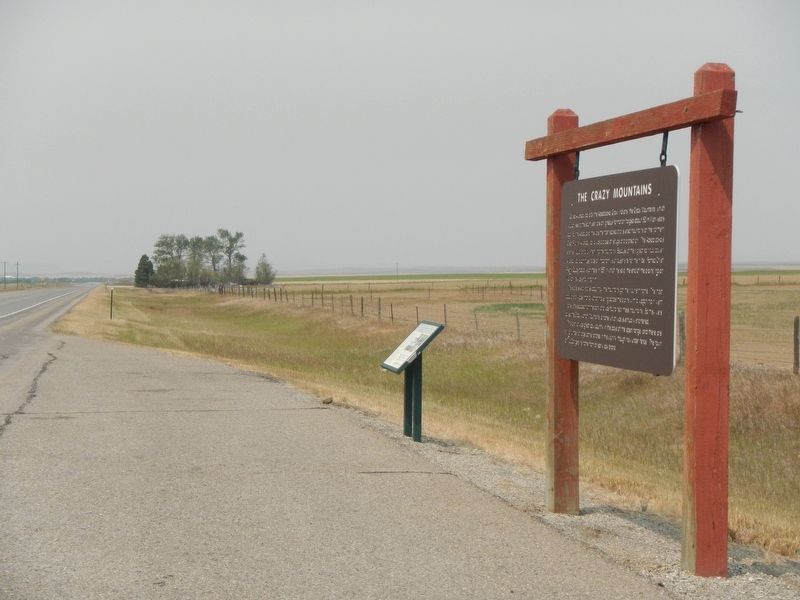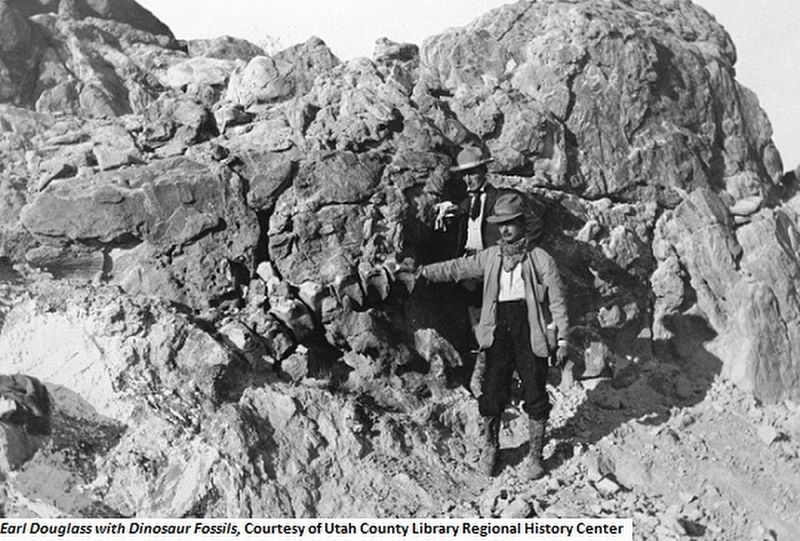Harlowton in Wheatland County, Montana — The American West (Mountains)
Paleocene Mammals and Albert Silberling
Inscription.
The town of Harlowton is located in the Fort Union Geological Formation, which was created about 65 million years ago, shortly after the dinosaur extinction. This once shallow inland sea was formed from rivers originating in the southwestern mountain slopes of Montana. These rivers transferred and deposited sediment collected fro the swampy, subtropical eastern coastal plains into the shallow sea. As the rivers shifted over time, swamp vegetation and peat were covered with thick deposits of sand, silt, and clay, which would later form coal. These deposits cemented and compacted into sandstone, siltstone, and mudstone.- soft materials that easily erode - leaving few outcrops of more weather-resistant rocks.
The area surrounding Harlowton is also famous for its Paleocene fossils. In 1902, Princeton University paleontologist Earl Douglass and Albert Silberling, a local homesteader and self-taught paleontologist, discovered the fossil remains of primitive mammals in a quarry southwest of Harlowton. Paleontologists excavated that quarry and three others over the next four decades and these sites yielded the remains of at least 23 species, including a squirrel-like animal called Ptilodus, the most successful of all mammals.
Ptilodus first appeared during the middle Jurassic Age about 160 million years ago and became extinct about 35 million years ago. It co-existed with massive sauropods, such as the Apatosaurus and Diplodous, as well as the meat-eating Allosaurus. During the Paleozoic time, Montana's climate was warm, humid, and possibly densely forested. With its dexterous feet, legs, and tail, Ptilodus was a good climber with a well-developed sense of smell. Teeth recovered in the quarries indicate that it was herbivorous. Other fossils found by Douglass and Silberling include a privative species of ungulate called Phenacodus, and a primative-like animal called Plesiadapis, all of which co-existed with Ptilodus and were preyed upon by Creodonts, the dominant carnivorous animal of the time. Albert Silberling's excavation of thousands of fossils and his discoveries from quarries in the Harlowton area have greatly contributed to scientists' knowledge about life in the Paleozoic Era.
Geo-Facts:
The Crazy Mountains are an intrusion of igneous rocks that pushed their way up through older sedimentary rocks about fifty million years ago. The rugged southern peaks of the range were sculpted by glaciers.
Earl Douglass and Albert Silberling collected 178 specimens from one quarry that included 23 species of mammals that were no larger than a modern rat.
Paleocene means "early dawn of the recent" in Greek.
The Paleocene Epoch immediately followed the massive extinction event at the end of the Cretaceous Era.
Geo-Actiivity:
Think about the types of mammals, landscape and climate described in the marker that once existed in the area and compare them to places and animals you see today. Look at the picture of Ptilodus, is there a similar animal where you live.
Erected by Montand Department of Transportation.
Topics. This historical marker is listed in this topic list: Paleontology. A significant historical year for this entry is 1902.
Location. 46° 26.772′ N, 109° 56.313′ W. Marker is in Harlowton, Montana, in Wheatland County. Marker is on U.S. 12 near Mexican John Road/ Muskrat Trail, on the right when traveling west. Touch for map. Marker is at or near this postal address: 9437 US Highway 12, Harlowton MT 59036, United States of America. Touch for directions.
Other nearby markers. At least 2 other markers are within 5 miles of this marker, measured as the crow flies. The Crazy Mountains (here, next to this marker); E57B The Last Electric Locomotive (approx. 5 miles away).
Also see . . . Earl Douglass -- Wikipedia. Earl Douglass (1862 – 1931) was an American paleontologist who discovered the dinosaur Apatosaurus, playing a central role in one of the most important fossil finds in North America. By 1922 Earl had unearthed and shipped more than 700,000 pounds of material including nearly 20 complete skeletons of Jurassic dinosaurs such as Diplodocus, Dryosaurus, Stegosaurus, Barosaurus, Camarasaurus and Brontosaurus. (Submitted on December 26, 2021, by Barry Swackhamer of Brentwood, California.)
Credits. This page was last revised on December 26, 2021. It was originally submitted on December 26, 2021, by Barry Swackhamer of Brentwood, California. This page has been viewed 166 times since then and 13 times this year. Photos: 1, 2, 3. submitted on December 26, 2021, by Barry Swackhamer of Brentwood, California.


